 |
||||||||||||||||||||||||||||||
| Wyvill Orientals | ||||||||||||||||||||||||||||||
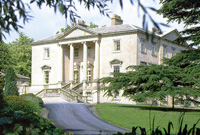 © Charles Wyvill Constable Burton Hall |
||||||||||||||||||||||||||||||
| The Wyvill name is legendary in the history of
the turf as it was the 5th baronet who imported the
famous Belgrade Turk. The Wyvills maintained a well known and distinguished stud during the time of the 4th, 5th and 6th baronets.
Their name is associated with some of the significant earlier horses in
the stud book and with some of the significant early bloodstock owners.
Yet even earlier Wyvills were involved with earlier horses and although
their contribution remains uncertain and speculative, it is possible that
they owned and bred some of the more anonymous bloodstock that engendered
the development of the thoroughbred racehorse. Constable Burton, near Leyburn in North Yorkshire, has been home to the Wyvill family since Christopher Wyvill acquired it around 1578 from the Scrope family of Masham (formerly of Bolton). Christopher married Margaret, daughter of the Hon John Scrope, youngest son of Henry (1534c-1592), 9th Baron Scrope of Bolton, and their son Sir Marmaduke Wyvill (1542c-1617) was created 1st Baronet of Constable Burton in 1612. Sir Marmaduke Wyvill (-1648), 2nd Baronet, was High Sheriff of Yorkshire and a committed royalist. By his marriage to Isabel, daughter of Sir William Gascoigne of Sedbury, he acquired the Sedbury property, around 1607, that was later home to many of the Royal Mares. He suffered considerable financial damage under the rule of Oliver Cromwell. Sir Christopher Wyvill (1614-1681), 3rd bt of Constable Burton, represented Richmond in parliament after the interregnum. He was said, by Dan Corker in an advertisement for Ramper, to have been Master of the Horse to Oliver Cromwell, although on the surface it seems highly unlikely that he served in any parliamentary post. The office of Master of the Horse at this time is traditionally attributed to John Claypole, son-in-law of Cromwell. It seems more probable that Sir Christopher served King Charles II and that perhaps such a service involved some of the duties of Master of the Horse or Master of the Stud. There is circumstantial evidence that Sir Christopher signed an invoice submitted by James Darcy for the purchase of bloodstock in 1667. Mr Cheny refers to Sir Christopher in an account of the Royal Mares: "King Charles the Second sent abroad the Master of the Horse (which some say was a late Sir Christopher Wyvill, others, the late Sir John Fenwick), in order to procure a Number of Foreign High-bred Horses and Mares for Breeding, and the Mares, thus procured by the said King's Interest, and brought to England (as also, many of their offspring) have for that Reason, been called Royal Mares". Considerable doubt has been expressed by Mr Prior and others that King Charles imported any Royal Mares, instead relying on the Darcy family to supply him with race horses annually, presumably from stock that descended from the Royal stables at Tutbury and Malmsbury, however there is no substantial evidence to support either argument. Sir Christopher married Ursula, the eldest daughter of Conyers Darcy, 1st Earl of Holderness, the latter the brother of James Darcy the Elder, with whom King Charles had contracted for racehorses. By this connection James Darcy the Elder acquired the use of Sedbury Park, although the transfer of ownership of Sedbury did not occur until Sir Christopher (Kitt) Darcy purchased it following the death of Sir William Wyvill (1645-1684), 4th Baronet. Sir Christopher was said to have owned the mare Lucky Sides, who appears in advertisements for the stallion Ramper (gr c 1736 Crab). It is intriguing to speculate that Lucky Sides was perhaps a relation of his grandson's "famous roan mare" reputed to be the great grandam of the Duke of Devonshire's legendary Flying Childers (b c 1714 Darley Arabian). Sir Christopher himself is credited with another "famous running roan mare" who is said to have been the great grandam of Bright's Roan (ro f 1695c Leedes Arabian). The Burton Blackatop Mare is yet another mare attributed to Sir Christopher. She was said to have been bred at Constable Burton and to be the sixth dam of the 6th baronet's Primate (bl c 1740 Young Belgrade). Sir William Wyvill (1645-1684), 4th bt, married Anne, the daughter of James Brooke of Ellingthorpe Hall, near Boroughbridge in Yorkshire. He owned the mare called Old Clubfoot (1680c) [ER:30], who was the third dam of Mr Hutton's Blacklegs (1725c Hutton's Bay Turk) and Mr Routh's Surley (gr c 1720 Hutton's Surley). Old Clubfoot is the taproot mare of Family 34. Sir Marmaduke Wyvill (1666c-1722), 5th bt, also represented Richmond in parliament and was later a commissioner of excise. He married Henrietta Maria Yarbrough, a maid of honour to Queen Catherine of Braganza (consort of King Charles II) and Queen Mary of Modena (consort of King James II). He was the owner of the "famous roan mare" who appears in the MS stud book of Cuthbert Routh as the great grandam of Flying Childers (b c 1714 Darley's Arabian) and Bartlet's Childers (b c 1716c Darley's Arabian). He is probably best known as the owner of the Belgrade Turk. Sir Marmaduke Wyvill (1692-1754), 6th bt of Constable Burton, continued the family tradition and represented Richmond in parliament in 1727. He was appointed Postmaster General of Ireland in 1736. His marriage to Carey Coke, niece of Edward Coke (owner of the Godolphin Arabian) in 1716 produced no heirs and the baronetcy passed to his nephew. He was the breeder of such horses as the Coalition Colt (b c 1749 Godolphin Arabian), the Scarborough Colt (bl c 1724 Tifter), Volunteer (b c 1735 Young Belgrade) and Antelope (b c 1748 Young Belgrade). |
||||||||||||||||||||||||||||||
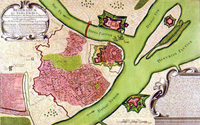 Belgrade, circa 1717 |
Belgrade Turk | |||||||||||||||||||||||||||||
| bbr c 1712c. Sire Line
Belgrade Turk. In the summer
of 1717 Prince Eugene of Savoy led an attack on Belgrade, Serbia
which had been occupied by the Turks. During the seige the
horse, later called the Belgrade Turk, was captured from the
Bashaw of Belgrade by Claudius Florimund, Comte de Mercie, who
was a general under the command of the French Prince. The count
sent him to the Prince de Craon, who in turn presented him to
Leopold, Duc de Lorraine (from 1690 to 1729). Leopold's son, Francis,
Duke of Lorraine and later Emperor of Germany, had been
schoolmate and friend to Edward Coke, of Longford Hall,
Derbyshire, the first English owner of the Godolphin Arabian.
Together they attended Luneville Academy and were hunting
companions. In 1716 Cary, the daughter of Edward Coke's older
brother, married Sir Marmaduke Wyvill, 6th bt. These connections
probably led to the purchase of the Belgrade Turk. In any case Belgrade Turk entered the Wyvill stud at Constable Burton. His introductory stallion advertisement reads, "A Brown Bay Turkish Horse, of a good Size, strong, and free from all Manner of Blemish, is kept at Constable Burton near Bedale, in Yorkshire, and allowed to serve Mares at a Guinea each: He was sent from Belgrade by General Mercie, and is Sire to the Mare which won the Subscription Money last Year at Richmond, being the first that was trained of his Breed" [Newcastle Courant, Saturday, March 22, 1728-9]. His fee was later raised to 5 guineas. He left two sons and six daughters, several of whom made significant contributions to the stud book. Belgrade Turk is said to have died around 1740, still in the possession of Sir Marmaduke Wyvill.
Statesman (GB) Young
Belgrade (GB)
|
||||||||||||||||||||||||||||||
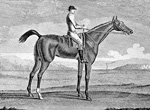 |
Antelope
(GB) b c 1748 (Young Belgrade - Mare, by Scarborough Colt). Sire Line Belgrade Turk. Family 18. Antelope was bred by the 6th Baronet, and raced for four years. He was sold to the Marquess of Hartington at the end of the 1753 season, and then to the Earl of Antrim in 1754. In 1752, he won £50 at New Malton in June, then at York he won the King's Plate, beating Mr Witty's Grenadier (b c 1746 Blaze) in both 4 mile heats, each carrying 12st. In September at Lincoln he won another King's Plate, beating Mr Ann's Partner (ch c 1748 Croft's Partner), each carrying 12st in four-mile heats. His only defeat in 1753 came from Grenadier in the King's Plate at Newmarket, each carrying 12st over four miles. He won the 90gs Ladies' Plate at Huntingdon, beating Richard Vernon's Crab (gr c 1744 Old Crab) in both three-mile heats. In April of 1754 he won the 100gs Jockey Club Plate at Newmarket, beating Richard Vernon's Danby Cade (b c Old Cade), Cumberland's Crab (gr c 1744 Old Crab) and Lord Strange's Sportsman (b c 1747 Derby Whitefoot). Each carried 8st 7lb in four-mile heats. He was said to have fallen lame a distance from home in the second heat. Later that year at Huntingdon he won the 90gs Ladies' Purse, beating Mr Vernon's Joseph (b g 1748 Godolphin Arabian), who was also called the Godolphin Gelding, in both three-mile heats. In April of 1754, as the property of Lord Antrim, he lost a 30 sovs race at Chester to Mr Read's Single Peeper (b c 1748 Regulus), all carrying 10st over four miles. He was retired to Lord Antrim's stud in Ireland where he was said to be a great favourite. His best son was probably Mr Pengree's Spanker. Although Antelope himself left no stock that bred on, his sisters made worthy contributions to Family 18. |
|||||||||||||||||||||||||||||
| Spanker (GB) br c 1758 (Antelope - Charming Molly, by Whitefoot). Sire Line Belgrade Turk. Family 13. In June of 1762 he won £50 at Bridgenorth, defeating Mr Bassett's Madge (gr f 1758 Regulus), Mr Aldridge's Newcombe (b c 1758 Newcombe Arabian) and two others. In May of 1763 he placed 2nd to Mr Allenby's Statesman (ch c 1758 Sultan), Mr Wentworth's Young Roger and others. Returning to Bridgenorth in June of 1763 he won another £50 plate, beating two others. In July he won £50 at Ludlow, beating two others, in August he won £80 at Worcester, beating Mr Howe's Render (Dormouse), Mr Burslew's Roger and Mr Kingsley's Liberty, and in September he won £50 at Gloucester, beating several others. He broke down at Maidenhead, having won the second heat, beating Sylla (Babraham), Americus, Cyclops and Venture. He entered the stud at Swalcliffe, Oxfordshire, for a fee of 2 guineas although he covered very few mares. |
||||||||||||||||||||||||||||||
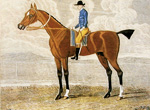 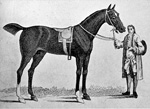 |
Volunteer
(GB) b c 1735 (Young Belgrade - Wyvill's Childers Mare, by Bartlet's Childers). Sire Line Belgrade Turk. Family 18. Volunteer was also bred by the 6th Baronet. Sir Marmaduke was married to Cary Coke, daughter of the elder brother of Edward Coke, owner of the Godolphin Arabian prior to Lord Godolphin. In April of 1742 at Newmarket he won the King's Plate, beating Mr Aislabie's [later Sir Edward O'Brien's] Poor Robin (ch c 1735 Robinson Crusoe), Mr Greville's Puff (b c 1735 Childers), (brother to the Duke of Devonshire's Blacklegs and Snip), and Mr Nunn's Staghunter, in three heats. In May he won £50 at Epsom, beating Mr Grisewood's Careless (ch c 1733 Bloody Buttocks). In June he won £50 at Guildford, beating the famous Old Traveller (b c 1735 Croft's Partner) in one heat. In July he won £50 at Nottingham, where he beat Mr Martindale's Sedbury (ch c 1734 Croft's Partner) in both four-mile heats. In 1743 Sir Marmaduke sent Volunteer to Ireland where he won several Plates and other prizes. There he was purchased by Sir Edward O'Brien (1705-1765), 2nd Baronet. He later died from an accident. Volunteer left no stock that bred on, however, his sisters were among the foundation mares of Family 18. |
|||||||||||||||||||||||||||||
| Old
Standard (GB) [ex-Bashaw] b c 1736 (Young Belgrade - Mare, by Tifter). Sire Line Belgrade Turk. Family 13. First called Bashaw, Standard was bred by Sir Marmaduke Wyvill and purchased following his first race by the Duke of Beaufort, who changed his name. In April of 1742 he won 60 guineas at Newmarket, beating the Duke of Ancaster's Foxhunter, Mr Bertie's Ramper (gr c 1736 Crab), the Duke of Devonshire's Snip (br c 1736 Childers) and Lord Godolphin's Molotto (bl c 1736 Godolphin Whitefoot) in four-mile heats. Later the same year he won the Prince of Wales's 60 guineas at Epsom, beating Mr Marley's Jinker, Mr Martindale's Smart and others. He next won the King's Plate at Guildford, beating Lord Portmore's Crab, Mr Dawkins's Whitestockings and Mr Grisewood's Dumplin. He was said to have won the latter two races in a very high form. He started for the King's Plate at Winchester against the Duke of Bolton's Sourface (gr c 1736 Bartlet's Childers) in which race he broke down. In the stud he got the brothers Jason (gr c 1749) and Figure (or Grey Figure, gr c 1747). |
||||||||||||||||||||||||||||||
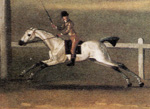 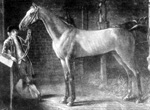 |
Jason
(GB) gr c 1749 (Old Standard - Mare, by Beaufort Arabian - Mare, by Brooke's Arabian - Mare, by Darley Arabian - Mare, by Brimmer). Sire Line Belgrade Turk. Jason was bred by Nathaniel Curzon and first named Bredwardian Castle. His pedigree as given in the General Stud Book differs from that shown above, in that the order of the last two mares is reversed. He raced first for Mr Curzon, and then for Sir James Lowther, to whom he was sold in 1756. His turf career spanned seven years, with more than fifteen victories, not including a year when he was used as a trial horse. He was beaten only once, by Mirza (b c 1749 Godolphin Arabian). In 1753 he won £50 at Cirencester, beating Sir John Moore's Clown (b c 1749 Regulus) and three others, carrying 9 stone for three heats. He later won 50 guineas at Litchfield, beating Lord Gower's Beau Clincher (b c 1749 Gower Stallion), Mr Curzon's Alfred (b c 1749 Sedbury), and three others. In 1754 at Epsom he won £50 beating Mr W Crofts's Basto (bl c 1748 Whitenose) and three others. He walked-over for £50 at Dunstable. At Litchfield he won the King's Plate, defeating in three heats Lord Gower's Beau-Clincher, the Duke of Cleveland's Charon (b c 1749 Philipson's Turk) and Mr Grisewood's Teazer (gr c 1749 Old Teazer). In October at Newmarket he won the 260 guineas Subscription Purse for five year olds beating Mr Panton's Spectator (b c 1749 Crab), Sir John Moore's Carlisle (b c 1749 Regulus) and two others. All carried 8 stone 7 pounds, and Jason's win came despite the broken stirrup leather of his jockey. In 1755 he won the King's Plate at Guildford defeating Mr Grisewood's Teazer. He then walked-over for the King's Plates at Winchester and Salisbury, won the King's Plate at Canterbury, and walked-over for the King's Plate at Lewes. In October at Newmarket he defeated Sir William Middleton's Whistlejacket (ch c 1749 Mogul) for the King's Plate there, each carrying 10 stone over the Beacon Course. In 1756 he won £50 at Stamford and £50 at Peterborough, in the latter beating Sir George Savile's Tom Thumb and Sir Charles Sedley's Royal (b c 1749 Regulus). At Huntingdon he won the 90 guineas Ladies' Purse beating, in three heats, Mr W Crofts's Brilliant (bu c 1750 Crab), Mr Panton's Pytho (gr c 1750 Crab) and Lord Gower's Ginger (bu c 1750 Shock), with Jason carrying 9 stone 11 pounds and the others carrying 8 stone 10 pounds. At Northampton he collected a 20 guineas premium since no horse would race against him. Jason was now purchased by Sir James Lowther. In May of 1757 he won the 200 guineas Jockey Club Plate at Newmarket beating Mr Panton's Spectator, Mr Shafto's Jessamy (ch c 1749 Hutton's Spot), Mr Crofts's Brilliant, Lord Rockingham's Whistlejacket (previously owned by Sir William Middleton), Mr Vernon's Forester (ch c Crofts's Forester) and one other. All carried 8 stone 7 pounds over the Beacon Course. In October at Newmarket he won a 500 guineas match against Lord Gower's Sweepstakes (b c 1749 Gower Stallion), over six miles, giving Sweepstakes 3 pounds. In September of 1758 he placed third in the Jockey Club Plate at Newmarket to Mr Greville's Mirza (br c 1749 Godolphin Arabian) and Mr Fenwick's Matchem (b c 1748 Cade), beating Mr Panton's Feather (b c 1751 Godolphin Arabian) and Mr Vernon's Forester, all carrying 12 stone for four miles. In 1759 Jason was used only as trial horse. In April of 1760 he won a 500 guineas match at Newmarket against Mr Shafto's Jessamy over the Beacon Course. This was Jason's final race and he retired to Sir James Lowther's stud. Although he sired several good runners during his stand at Lowther Castle, Westmoreland, he left no stock that bred on. |
|||||||||||||||||||||||||||||
Figure (GB) gr c 1747 (Old Standard - Mare, by Beaufort Arabian - Brooke's Arabian - Darley Arabian - Brimmer). Sire Line Belgrade Turk. Figure, often called Grey Figure, was bred by Mr Curzon and sold to the Duke of Hamilton. In 1753 he won £50 at Peterborough, beating Mr Vernon's Crab (gr c 1744 Crab), Mr Leath's Fen Filly and Mr Nelson's Greylegs in three heats. He also won £50 at Belford, beating Lord March's Wanton (b c 1747 Cade). In 1754 he won £50 at Epsom, beating Mr Rogers's Soldier (ch c 1747 Sedbury) and Mr Adams's True Blue in three heats. He then won a £50 give and take at Dunstable, Hertfordshire, beating Sir Charles Sedley's Lady Augusta, Mr Vernon's Fire, Mr Stoke's Smiling Ball and Mr Brooke's Lady Thigh (b f 1747 Grisewood's Partner) in three heats. In 1755 he won £50 at Epsom, beating Mr Burlton's (later Mr Vernon's) Amelia (b f 1748 Godolphin Arabian) and Lord Onslow's Victorious (bl c 1747 Portmore's Whitenose) in three heats. His most notable son was Figure*. |
||||||||||||||||||||||||||||||
|
Figure (GB)* br c 1757 (Figure - Mariamne, by Portmore's Victorious - Croft's Partner - Richardson's Merlin - Makeless - Burford Bull - Devonshire Arabian). Sire Line Belgrade Turk. Figure* won four Fifties in England and Scotland before his export to Maryland in 1765. Standing about 15.2 hands, he ran in several races and won at Annapolis in 1766. He stood variously in Maryland, New Jersey and New York and got excellent stock, particularly from the Selima* (b f 1745 Godolphin Arabian) branch of Family 21, including two useful sons, Spotswood's Don Carlos (b c 1772), sire of Brent's Driver (br c 1782), and Skipwith's Figure (b c 1770). His daughter Shrewsbury was the dam of both Hall's Union (b c 1777 Slim*) and Van Rantz's Potomac (b c 1796 Messenger*). Another son, Young Figure (b c 1769) sired Heard's Snap (b c 1771). Figure's mating with Maria Slamerkin of Family 4-r ensured his presence in most of the world's bloodstock via their descendant Nearco (br c 1935 Pharos). |
||||||||||||||||||||||||||||||
| Lord Perl | ||||||||||||||||||||||||||||||
| Lord Perl c 1710c. Owned by the 5th baronet, he was said to be a white barb in the MS stud book of Cuthbert Routh [ER:39,55]. He sired only one known offspring, Cuthbert Routh's 1725 grey colt from his sister to Hanniball (b f 1716c Terror). |
||||||||||||||||||||||||||||||
| Wyvill's Golden Arabian | ||||||||||||||||||||||||||||||
| [Wyvill's Dun Turk] c 1710c. Owned by the 5th baronet, he sired the famous galloway mare, Golden Dun, who won a £40 plate at York in 1723, defeating Sir William Lowther's Surley, Sir Michael Warton's Molly, Mr Newton's Betty Garnet and Mr Dobinson's Chance. She was later the second dam of Magnifico (b c 1748 Regulus). Magnifico finished 2nd for a couple of fifties in 1753 and 1754 running first for Sir Marmaduke and then for Mr Palmer. The Golden Arabian and was said to have died after covering only two or three mares [Pond 1754:156]. | ||||||||||||||||||||||||||||||